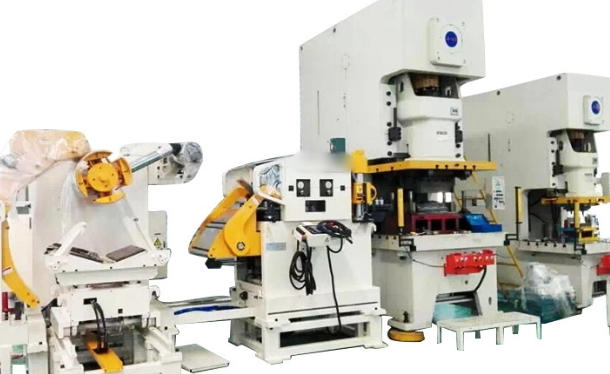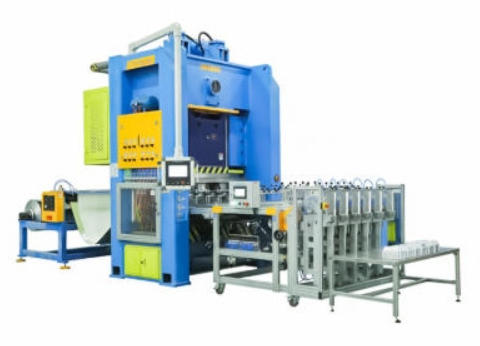Views: 222 Author: Rebecca Publish Time: 2025-11-18 Origin: Site









Content Menu
● What is a Punch Press Machine?
● Historical Background: The Evolution of Cutlery Production
● The Modern Punch Press: Technology and Operation
● Benefits of Punch Press Machines in Cutlery Manufacturing
>> 1. Consistent Precision and Symmetry
>> 2. Increased Production Speed
>> 3. Energy Efficiency and Cost Savings
>> 5. Safety and Automation Integration
● Integration into Modern Smart Factories
● Advanced Technologies Transforming the Process
>> Predictive Maintenance and AI
● Case Application: Stainless Steel Cutlery Production
● Impact on Sustainability and Green Manufacturing
● Economic and Strategic Advantages
● Design Innovation Through Punch Press Technology
● The Future of Punch Press Applications in Cutlery
● FAQ
>> 1. How does a punch press machine improve quality control in cutlery manufacturing?
>> 2. What type of punch press is most suitable for cutlery production?
>> 3. Can punch press machines handle both stainless steel and titanium materials?
>> 4. What are the main safety features of modern punch press machines?
>> 5. How are punch press machines contributing to sustainable manufacturing?
The cutlery industry plays a vital role in global dining, hospitality, and household markets. Every restaurant, kitchen, and catering business depends on billions of pieces of knives, forks, and spoons produced annually. As consumer demand evolves toward precision, aesthetics, and sustainability, manufacturers are under pressure to modernize their production lines. One of the most transformative technologies driving this change is the punch press machine.
Originally designed for general metal forming, punch press machines have evolved into advanced CNC-controlled systems capable of producing intricate cutlery designs with outstanding speed, uniformity, and surface quality. Their integration into manufacturing facilities has boosted efficiency, reduced waste, and sparked a design renaissance. This article explores how punch press technology is reshaping the global cutlery industry, from material processing and energy efficiency to sustainability and future innovations.

A punch press machine is a precision metalworking tool that shapes, cuts, or perforates sheet materials using a punch and die mechanism. These machines can operate mechanically, hydraulically, or via advanced servo-electric systems. The primary goal is to exert controlled force on sheet metal—often stainless steel—to produce perfectly shaped components.
In cutlery manufacturing, punch presses are used to form knife blanks, fork prongs, and spoon heads from flat sheets. The machine can also integrate bending and embossing processes, enabling embossed logos or decorative details that enhance visual appeal. When paired with CNC control, punch presses execute these functions automatically and with repeatable accuracy.
Cutlery crafting began as an artisanal trade. Early blacksmiths forged individual utensils by hand, hammering and shaping red-hot metal. The process was slow and inconsistent, resulting in limited production volumes. The 19th century brought mechanical stamping presses powered by steam engines, ushering in the era of industrial cutlery manufacturing.
However, these early presses had limitations—they were noisy, lacked precise control, and required heavy manual labor. The transition to electrically driven and computer-controlled punch presses in the late 20th century revolutionized this process. Modern equipment now allows for fully automated operations where human intervention is limited to programming and maintenance. It marks a shift from craftsmanship to smart manufacturing while maintaining exceptional precision.
Today's punch press machines are equipped with servo-electric drives and intelligent control systems. These advancements enable precise regulation of pressure, stroke rate, and alignment. The machine's key components include:
- Frame: A heavy-duty structure ensuring rigidity and stability during high-pressure operations.
- Punch and Die Set: Tools that define the shape of each cutlery piece.
- Ram and Slide Mechanism: Transfers force from the drive system to the punch.
- CNC Control System: Stores design programs and automates setup for various patterns.
- Feeding System: Automatically moves sheet metal through multiple operations with exact positioning.
As a result, each blank of stainless steel can be consistently transformed into precision utensil shapes within seconds, ensuring reproducible quality across mass production.
Cutlery products require dimensional consistency for aesthetic and ergonomic reasons. Punch presses provide stability through controlled movement and accurate pressure distribution. The result is smooth-edged, perfectly balanced utensils that meet ISO and EU standards for consumer products.
Automation allows high-speed, repeatable cycles. A CNC punch press can produce tens of thousands of components per day, far exceeding manual or semi-automatic systems. Quick tooling changes also enable diverse product runs without major downtime.
Traditional forging uses extreme heat, which consumes large amounts of energy. Punch pressing uses mechanical deformation at ambient temperature. Servo-electric systems consume energy only when in motion, lowering operating costs by up to 30 percent compared with hydraulic models.
No longer limited to uniform industrial outputs, modern punch presses allow customization. Manufacturers can program different utensil patterns, add decorative cutouts, or adjust depth and curvature for ergonomic comfort. This flexibility responds to the global trend of personalized dining ware.
Sensor technology continuously monitors pressure and alignment, eliminating operator risk. Automatic shut-off mechanisms stop the press in milliseconds when irregularities occur, protecting both machinery and personnel.

Punch press machines are central to digitalized manufacturing setups. Their integration with IoT platforms enables real-time data collection for improved process visibility and predictive maintenance. In a typical smart cutlery production facility:
1. CAD software generates a die design optimized for material usage.
2. The CNC punch press imports the design directly via digital interface.
3. Robotic feeders load stainless sheets seamlessly.
4. Output quality is automatically inspected using AI-driven visual scanners.
5. Any variation triggers automatic recalibration through feedback loops.
This closed-loop workflow ensures high throughput and traceability, essential for international quality standards and supply chain transparency.
Replacing hydraulic systems, servo drives deliver quieter operation and smoother motion. The stroke depth and speed are fully programmable, allowing delicate operations on thin metal sheets commonly used in cutlery production.
Turret systems house multiple punch tools in a rotating disk that can change tools in seconds. For example, a single production cycle can switch from stamping knife blades to spoon bowls without halting the line. This multi-function capability increases versatility and overall yield.
Hybrid punch-laser machines now exist, combining mechanical pressing with laser cutting for edges requiring extra precision or complex patterns. Such systems reduce tooling costs and open new design possibilities, such as decorative engravings on luxury cutlery.
Artificial intelligence analyzes thousands of press cycles to predict tool wear or alignment drift. Early alerts prevent downtime, extending machine lifespan and ensuring continuously high-quality output.
Stainless steel is the material of choice for most cutlery because of its resistance to corrosion, heat, and staining. The typical production process includes:
1. Sheet Preparation: Stainless steel coils are flattened and cleaned.
2. Punching: Sheets are fed into a CNC punch press to cut knife, fork, and spoon blanks.
3. Forming: Some punch presses incorporate secondary forming tools to curve spoon heads or fork tines.
4. Trimming and Deburring: Edges are smoothed automatically to eliminate sharp burrs.
5. Heat Treatment and Polishing: Blanks are hardened, ground, and polished into final form.
6. Inspection and Packaging: Finished items pass automated quality checks before packaging.
This streamlined flow—largely driven by punch press automation—ensures consistency, hygiene, and speed needed for international distribution.
Environmental compliance is a growing concern in metal fabrication. Punch press machines contribute to sustainability in several meaningful ways:
- Reduced Material Waste: Advanced nesting software arranges cutlery shapes on metal sheets to maximize yield and minimize scrap.
- Lower Carbon Footprint: No need for high-temperature furnaces during shaping drastically cuts carbon emissions.
- Quiet, Clean Operation: Servo-electric presses produce less noise and require no hydraulic oil, reducing contamination risks.
- Recyclable Outputs: The stainless-steel scraps generated are easily recycled back into the production cycle.
These advancements align with global ESG (Environmental, Social, and Governance) standards, helping cutlery manufacturers meet international sustainability certifications.
Factories using modern punch press lines enjoy lower unit costs, shorter delivery times, and higher consistency, giving them a competitive edge in international markets. Automation also reduces dependence on skilled manual operators, addressing labor shortages in developed and emerging economies alike.
Restaurants and hospitality brands often order personalized cutlery sets featuring corporate logos or thematic engravings. CNC punch systems can produce these variations without expensive mold changes, enabling low-volume, high-value production.
Combining punching, forming, and embossing within one system drastically shortens manufacturing time. This agility allows rapid product development cycles—important in an industry with evolving customer preferences.
The aesthetics of modern cutlery depend heavily on material shaping precision. Punch presses enable delicate design features such as:
- Laser-like apertures for decorative patterns.
- Fine embossing of brand logos.
- Ergonomic curvature adjustments optimized by computer simulation.
Manufacturers leverage AI-assisted CAD design to create products that feel balanced in hand and stand out in presentation. Premium lines increasingly combine artistic design with uniform functionality—something only achievable at scale using advanced pressing systems.
Looking ahead, punch press technology will become even more adaptive and intelligent. The next generation of machines is expected to feature:
- Digital Twin Technology: Virtual simulations of pressing operations before production begins.
- Cloud Data Integration: Global production teams can access and adjust press settings remotely.
- Smart Material Recognition: AI systems automatically detect sheet thickness and alloy composition for optimized performance.
- Advanced Tool Materials: Development of ultra-durable tungsten carbide punches with longer lifespans and consistent sharpness.
With these innovations, manufacturers will be able to transition to full 24/7 autonomous operation, increasing consistency while lowering maintenance costs.
The punch press machine stands as a pillar of innovation in the cutlery industry. It has redefined production efficiency, material usage, and product consistency, allowing manufacturers to meet growing demands with precision and cost control. By merging mechanical expertise with digital automation, manufacturers now achieve perfect symmetrical utensils faster and cleaner than ever before.
Punch press technology is more than a manufacturing upgrade—it represents a new industrial philosophy centered on adaptability, sustainability, and intelligent automation. As the global appetite for durable, beautifully designed cutlery increases, the role of punch press machines will continue to expand, ensuring that every piece produced is a symbol of advanced engineering and refined craftsmanship.

It provides consistent pressure and programmable accuracy, eliminating variations caused by manual labor. Every pressed piece matches the digital design precisely, ensuring reliability and uniformity.
Servo-electric CNC punch presses are preferred due to their speed, accuracy, and energy efficiency. They also have flexible control systems that can handle complex cutlery shapes.
Yes. Modern machines can process multiple alloys. The programmable stroke and adjustable pressure settings adapt easily to titanium, nickel, or stainless steel without compromising precision.
They include automatic overload detection, emergency stops, pressure sensors, and guarding systems that prevent human access to moving parts during operation. These features align with international safety standards.
By reducing energy use, minimizing scrap, and enabling closed-loop recycling of stainless steel waste, they lower environmental impact while maintaining production efficiency.
Why The Right Punch Press Machine Is Crucial for High-Quality Tableware Production?
Punch Press Machines: The Backbone of Efficient Cutlery Production
How To Choose Between Manual And Automatic Punch Press Machines?
Best Punch Press Machines for Small And Large-Scale Manufacturers
Top Manufacturers of Punch Press Machines for The Tableware Industry
What Are The Key Benefits of Investing in A Punch Press Machine for Your Factory?
How Punch Press Machines Are Revolutionizing The Cutlery Industry?
The Role of Punch Press Machines in Modern Kitchenware Production Lines
Punch Press Machine Vs. Turret Punch Press: What's The Difference?
